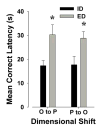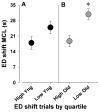The mouse attentional-set-shifting task: a method for assaying successful cognitive aging?
- PMID: 20498348
- PMCID: PMC2877277
- DOI: 10.3758/CABN.10.2.243
The mouse attentional-set-shifting task: a method for assaying successful cognitive aging?
Abstract
Humans exhibit considerable variance in cognitive decline with age, with some exhibiting little disruption and others becoming significantly impaired. In aged rodents, individual differences in spatial memory have been used to identify putative compensatory mechanisms underlying successful hippocampal aging. However, there are few parallel rodent models of cognitive decline in frontal-cortex-mediated functions. We tested the hypothesis that, like aged humans, aged mice would exhibit greater variance in executive function measures, as compared with young mice. We examined the performance of young and aged C57BL/6N mice in the attentional-set-shifting task. Whereas young and old mice did not differ on trials-to-criterion performance, aged mice exhibited significantly greater variance in mean correct latency-selective to the extradimensional shifting stage-as compared with their younger counterparts. Thus, this task may be used to identify mechanisms underlying individual differences in decline of frontal-mediated performances with age.
Figures





Similar articles
-
The ultimate intra-/extra-dimensional attentional set-shifting task for mice.Biol Psychiatry. 2014 Apr 15;75(8):660-70. doi: 10.1016/j.biopsych.2013.05.021. Epub 2013 Jun 28. Biol Psychiatry. 2014. PMID: 23810621
-
Aged rats are impaired on an attentional set-shifting task sensitive to medial frontal cortex damage in young rats.Learn Mem. 2002 Jul-Aug;9(4):191-201. doi: 10.1101/lm.48602. Learn Mem. 2002. PMID: 12177232 Free PMC article.
-
Early discrimination reversal learning impairment and preserved spatial learning in a longitudinal study of Tg2576 APPsw mice.Neurobiol Aging. 2007 Aug;28(8):1248-57. doi: 10.1016/j.neurobiolaging.2006.05.034. Epub 2006 Jul 7. Neurobiol Aging. 2007. PMID: 16828204
-
Attentional Set-Shifting Across Species.Curr Top Behav Neurosci. 2016;28:363-95. doi: 10.1007/7854_2015_5002. Curr Top Behav Neurosci. 2016. PMID: 26873018 Review.
-
Attentional set-shifting in rodents: a review of behavioural methods and pharmacological results.Curr Pharm Des. 2014;20(31):5046-59. doi: 10.2174/1381612819666131216115802. Curr Pharm Des. 2014. PMID: 24345263 Review.
Cited by
-
Old dog, new tricks: the attentional set-shifting test as a novel cognitive behavioral task after controlled cortical impact injury.J Neurotrauma. 2014 May 15;31(10):926-37. doi: 10.1089/neu.2013.3295. Epub 2014 Apr 10. J Neurotrauma. 2014. PMID: 24397572 Free PMC article.
-
Dopamine receptor mediation of the exploratory/hyperactivity effects of modafinil.Neuropsychopharmacology. 2011 Jun;36(7):1385-96. doi: 10.1038/npp.2011.23. Epub 2011 Mar 16. Neuropsychopharmacology. 2011. PMID: 21412225 Free PMC article.
-
Early Adolescent Emergence of Reversal Learning Impairments in Isolation-Reared Rats.Dev Neurosci. 2015;37(3):253-62. doi: 10.1159/000430091. Epub 2015 May 23. Dev Neurosci. 2015. PMID: 26022788 Free PMC article.
-
Nucleus Accumbens Core Dopamine D2 Receptor-Expressing Neurons Control Reversal Learning but Not Set-Shifting in Behavioral Flexibility in Male Mice.Front Neurosci. 2022 Jun 28;16:885380. doi: 10.3389/fnins.2022.885380. eCollection 2022. Front Neurosci. 2022. PMID: 35837123 Free PMC article.
-
Performance of C57BL/6J and DBA/2J mice on a touchscreen-based attentional set-shifting task.Behav Brain Res. 2014 Mar 15;261:158-70. doi: 10.1016/j.bbr.2013.12.015. Epub 2013 Dec 18. Behav Brain Res. 2014. PMID: 24361287 Free PMC article.
References
-
- Abraham NM, Spors H, Carleton A, Margrie TW, Kuner T, Schaefer AT. Maintaining accuracy at the expense of speed: stimulus similarity defines odor discrimination time in mice. Neuron. 2004;44(5):865–876. - PubMed
-
- Anstey KJ, Low LF. Normal cognitive changes in aging. Aust Fam Physician. 2004;33(10):783–787. - PubMed
-
- Ashendorf L, McCaffrey RJ. Exploring age-related decline on the Wisconsin Card Sorting Test. Clin Neuropsychol. 2008;22(2):262–272. - PubMed
Publication types
MeSH terms
Grants and funding
LinkOut - more resources
Full Text Sources
Medical
